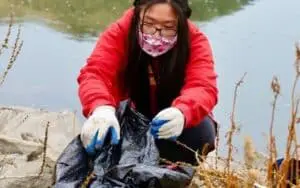This article contains collapsible sections with activity materials, instructions, and additional resources. Use the expand/collapse buttons to view each section.
Activity Content Sections
Click to expand or collapse the introduce section
This project asks students to research what an area in their community was like before human activity changed it. Once students are familiar with an area’s natural history, they’ll design engineering-based solutions to reclaim the health of that habitat.

Picture your community—its busy areas, neighborhoods, parks, and water sources such as lakes or streams. Now imagine your community the year you were born. What animals and plants lived there? Do they still live there? What about 50 or 100 years ago?
A habitat is a place within an ecosystem where a plant or animal lives. Living things have evolved to thrive in their native habitat, with a particular landscape, climate, dominant vegetation, and water source. When a habitat becomes polluted, overtaken by invasive non-native species, broken into small pockets by highways or subdivisions, or degraded by other sources of rapid change, many species will not be able to adapt. Habitat destruction is causing countless plants and animals to drastically decline in number, some to the point of extinction.
Environmental engineers reverse the process of habitat loss by working with biologists, ecologists, conservationists, geologists, and many other kinds of scientists to restore habitat. The work requires a deep knowledge of the ecology and natural history of a particular environment, as well as the ability to think
ahead and plan for future potential threats to a habitat’s well-being.
Your STEM Project:
Plan the restoration of a degraded habitat in your community so that it benefits native plants and animals.
Challenge Instructions
Project Management Templates (Word version)
This project meets the following Next Gen Science Standards:
Design, evaluate, and refine a solution for reducing the impacts of human activities on the environment and biodiversity.
Evaluate competing design solutions for developing, managing, and utilizing energy and mineral resources based on cost-benefit ratios.
Design a solution to a complex real-world problem by breaking it down into smaller, more manageable problems that can be solved through engineering.
This project is aligned with the following United Nation’s Sustainable Development Goals:
Join our community and receive activities, early access to programs, and other special news, and/or leave feedback on this activity below!
All of the content on this site is free!
Registering for the site helps us tailor future activities, webinars, and events so that we can serve you better.
Thank you for your interest and for helping us in our mission to transform lives as we put the E in STEM!
91 Comments
This is really good! I appreciate your approach to STEM studies.
Great STEM enrichment.
Good
I’m planning on utilizing it this spring. I want to find a middle school version or modify as well
Looking at it when I have time. Trying to figure out how to download
I love all the possible connections a project like this could create. Can’t wait to see more of what you do!
Love the efforts to clean up, anywhere any time! Thank you
8-9th grade any many activities
This is the wonderful activities for the estudents, and STEAM plans
Anxious to try it
sgj416@gmail.com
Trackbacks/Pingbacks